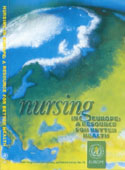Nursing in Europe. A resource for better health

Download
Edited by Jane Salvage & Serge Heijnen
WHO Regional Publications, European Series, No.74
1997, 278 pages
ISBN 92 890 1338 9
This publication is only available online.
What is the most important resource for health that a European country has today? Countries would give different answers to this question, but all of them would put the work of nurses very high on the list. The sheer number of the profession is close to 5 million in the 50 countries of the WHO European Region. Nurses are not a homogeneous group, but taken together they comprise a formidable workforce that provides some of the most essential services to keep people healthy, to take care of the ill and the injured, and to nurse the frail and elderly. In many, if not most, European countries, however, these health professionals unfortunately do not get the recognition they deserve, or the working facilities they need to carry out their unique function in our health care systems.
The WHO Regional Office for Europe has had a very strong programme in nursing for many years, because it believes that only a well trained community nurse can really be the first line of defence of the primary health care system. The model that WHO foresees is the one that emerged in 1988 from WHO's First European Conference on Nursing in Vienna, by which a nurse is responsible for providing a broad community-based service (including lifestyle counselling, diagnosis of health problems and home care for the sick, frail and elderly) in addition to the important nursing function in the hospital sector. In spite of intensive work since the Conference, however, nurses are still far from that situation in many Member States. There is an urgent need for countries thoroughly to revise their policies, infrastructures and training programmes for nursing to make them compatible with the WHO models.
The nursing and midwifery programme in the Regional Office is working hard to attain these objectives, and the first requirement is an understanding of the current situation. This will provide a sound foundation for new initiatives and indicate the urgent needs for reform. This book, the first of its kind, gives a thorough overview of the current state of nursing and midwifery in Europe, and contains a wealth of extremely useful information for nurses, their professional organizations, ministries of health, ministries of education and other bodies that are interested in promoting better health and improving health services in the European Region.



